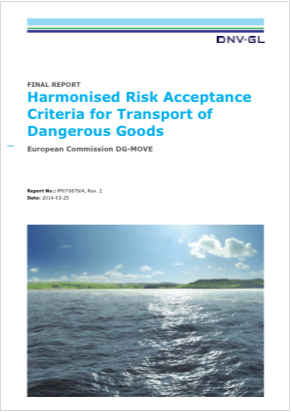Harmonised Risk Acceptance Criteria Transport of Dangerous Goods
| Appunti Merci Pericolose | ||
| 06 Luglio 2025 | ||
| Salve Visitatore | ||
Harmonised Risk Acceptance Criteria Transport
The transport of dangerous goods (TDG) throughout the inland regions of the European Union (EU) is governed by Directive 2008/68/EC and the ADR, RID and ADN regulations for road, rail and inland waterways respectively. In principle, these uniform regulations should permit free movement of dangerous goods (DG) at an acceptable level of safety. The European Commission Directorate-General for Mobility and Transport (DG-MOVE) has therefore commissioned Det Norske Veritas Ltd (DNV) to perform a feasibility study on harmonising RAC for TDG in the EU. DNV’s proposed harmonised approach to RAC includes seven distinct elements: 3. Societal risk (SR) criteria, expressed as FN curves for the most exposed communities. Above this, measures to reduce catastrophe risk should be investigated. 4. Scrutiny level, expressed as an expectation value of fatalities per tonne of DG transported over a route. Above this, justification of the transport would be needed, and additional restrictions or safety measures should be investigated. The scrutiny level aims to ensure that the risks of TDG are justified by its benefits. 5. ALARP criteria (i.e. defining what is as low as reasonably practicable), consisting of either qualitative or cost-benefit criteria for evaluation of additional restrictions or safety measures. This aims to ensure that safety measures are optimised, taking account of the costs and benefits of risk reduction. 6. Improvement target for TDG, expressed as an expectation value of fatalities per year from all modes of TDG. This would be used to monitor performance and propose additional safety measures. 7. Improvement target for DG, expressed as an expectation value of fatalities per year from all production and transport of DG. This would be a possible way of monitoring and improving consistency with requirements for fixed installations. Only two of these elements (RAC 2 and 5) would determine the need for additional restrictions or safety measures. The other RAC are aimed at minimising analysis effort (RAC 1) and focussing improvement efforts (RAC 3, 4, 6 and 7). The relationships are summarised in Figure 1. Figure 1 Summary of Harmonised RAC In most TDG cases the core of the evaluation would be the ALARP criteria (RAC 5). In simple terms, provided risks have been considered on a broad scale, and are not exceptionally high by any of the other RAC, a restriction on TDG can only be justified if it is necessary to make the risks ALARP, i.e. if the costs of the restriction are outweighed by its benefits in terms of risk reduction, or if it is judged to comprise part of good operating practice. more... European Commission DG-MOVE 2014 |
||
 |
||
|
è un sito di INVIO NEWSLETTTER Se vuoi cancellarti dall'invio della newsletter oppure effettua il login al sito ed entra nella Tua Area Riservata, in “Modifica dati” agisci con la spunta sul box di selezione “Newsletter”. L'Elenco completo di tutte le ns newsletter è qui: Archivio newletter |
||
  |
||
| Certifico Srl 2000-2018 | VAT IT02442650541 | ||



































